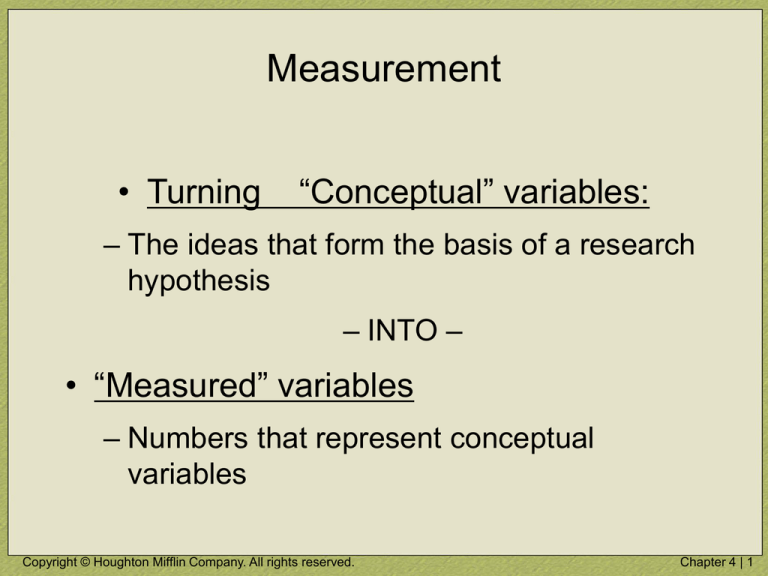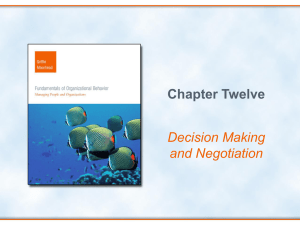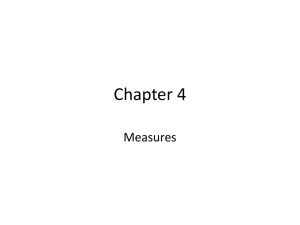
Measurement
• Turning
“Conceptual” variables:
– The ideas that form the basis of a research
hypothesis
– INTO –
• “Measured” variables
– Numbers that represent conceptual
variables
Copyright © Houghton Mifflin Company. All rights reserved.
Chapter 4 | 1
Conceptual and Measured Variables in a
Correlational Research Design
Copyright © Houghton Mifflin Company. All rights reserved.
Chapter 4 | 2
Operational Definition
• Operational definition
– a precise statement of how a conceptual
variable is turned into a measured variable
Copyright © Houghton Mifflin Company. All rights reserved.
Chapter 4 | 3
Converging Operations
• Converging operations
– We use different operationalizations of the
same conceptual variable to triangulate
(hone in) on the conceptual variable
– How might you “converge” on the
conceptual variable “attraction” ? Write two
operational definitions for the variable.
Copyright © Houghton Mifflin Company. All rights reserved.
Chapter 4 | 4
Operational Definitions
Copyright © Houghton Mifflin Company. All rights reserved.
Chapter 4 | 5
Types of variables
• Nominal variable
– Used to name or identify a particular
characteristic (e.g., sex, religion)
• Quantitative variable
– Uses numbers to indicate the extent to
which a person possesses a characteristic
(e.g., shyness, intelligence)
Copyright © Houghton Mifflin Company. All rights reserved.
Chapter 4 | 6
Types of Measurement Scales
• Interval scale
– Equal distances between scores on a measure
are known to correspond to equal changes in the
conceptual variable (e.g., Fahrenheit)
• Ratio scales
– Interval scales that also have a true zero point
• Ordinal scale (most common in behavioral research)
– Numbers indicate whether there is more or less of
the conceptual variable, but do not indicate the
exact interval between the individuals on the
conceptual variable (e.g., rating scales)
Copyright © Houghton Mifflin Company. All rights reserved.
Chapter 4 | 7
Measures
• Self-report vs. behavioral
• Self-report measures
– Free-format vs. fixed format (next slide)
Copyright © Houghton Mifflin Company. All rights reserved.
Chapter 4 | 8
Free-Format Self-Report Measures
• Free-format self-report measures
– Allow respondents to indicate whatever thoughts
or feelings they have about the topic, without any
constraints imposed (e.g., projectives)
– Produce a rich set of data
– Very difficult and time-consuming to turn the
generated thoughts into a set of measured
variables
– Hard to compare individuals
Copyright © Houghton Mifflin Company. All rights reserved.
Chapter 4 | 9
Fixed-Format Self-Report Measures
• Fixed-format self-report measures
– The individual is presented with a set of
questions called items combined into a
scale
– Likert scale (most popular) -- consists of a
series of items that indicate agreement or
disagreement with the issue that is to be
measured
– Your homework assignment
Copyright © Houghton Mifflin Company. All rights reserved.
Chapter 4 | 10
Acquiescent Responding
• Acquiescent responding
– May occur if all the items on a Likert scale
are phrased in the same direction
– Not possible to tell if the respondent is
simply tending to agree with everything or
if he or she really agrees with the content
of the item
Copyright © Houghton Mifflin Company. All rights reserved.
Chapter 4 | 11
Semantic Differential
• Semantic differential
– The topic being evaluated is presented
once at the top of the page
– Items consist of pairs of adjectives located
at the two endpoints of a standard
response format
Copyright © Houghton Mifflin Company. All rights reserved.
Chapter 4 | 12
Reactivity
• Reactivity
– Changes in responding that occur when
individuals know they are being measured
– Example: Social desirability -- tendency to
present self in a positive or socially
acceptable way to the researcher
Copyright © Houghton Mifflin Company. All rights reserved.
Chapter 4 | 13
Behavioral Measures
• Measure behavior directly
• Types of behavioral variables include:
– Frequency, Duration, Intensity, Latency, Speed
– See Table 4.5
– Psychophysiological measures
• Advantages / Disadvantages?
– nonreactive
Copyright © Houghton Mifflin Company. All rights reserved.
Chapter 4 | 14











